Bonsai, an ancient horticultural art form that originated in China over a thousand years ago, involves cultivating miniature trees that mirror the shape and style of mature, full-sized trees. Pruning, an integral part of Bonsai cultivation, is more than a mere aesthetic act. It contributes to the overall health and longevity of these trees. Bonsai trees, despite their miniature size, can live for hundreds of years, and regular, meticulous pruning is a significant contributor to their longevity. A 2020 research article published in “HortScience” demonstrated that the strategic pruning of Bonsai trees can indeed enhance their lifespan and aesthetic appeal.
For indoor Bonsai trees, pruning essentially involves selective branch removal to maintain the tree’s shape and size, improve its structure, and encourage new growth. To ensure optimal results, it’s essential to identify the correct time for pruning, use the right tools, apply precise techniques, and care for the tree after the pruning process.
In this article, we unfold the mystery of Bonsai tree pruning. From the meaning of pruning in the context of Bonsai, to understanding when and how to prune, identifying the necessary tools, and mastering the techniques—we’ve got it all covered. We also share insights into avoiding common mistakes and troubleshooting problems after pruning. So, if you’re eager to ensure the health and aesthetic appeal of your indoor Bonsai trees, this comprehensive guide is your go-to resource.

What Does Pruning Mean in the Context of Indoor Bonsai Trees?
Pruning is a horticultural and silvicultural practice involving the selective removal of certain parts of a plant, such as branches, buds, or roots. But when it comes to indoor Bonsai trees, pruning is much more than a mere maintenance procedure; it’s an interweaving of art and science, where horticultural knowledge meets aesthetic creativity.
The scientific aspect of pruning focuses on the physiological responses of the tree. Each cut you make influences how the tree will grow, as plants generally respond to pruning by becoming denser. When you prune a branch of your Bonsai, the tree redirects its energy towards producing new growth. This reaction allows you to control the shape of the tree and encourage growth in the desired areas.
From an artistic perspective, pruning is the primary method through which the Bonsai tree is styled. This process involves a delicate balance of maintaining the tree’s health while guiding its shape and size to mirror nature on a smaller scale. The goal is to create a miniature tree that, despite its size, embodies the elegance and proportion of a full-sized tree.
In the realm of Bonsai, there are two primary forms of pruning: maintenance and structural.
- Maintenance Pruning: This procedure is akin to routine cleanup and is essential for keeping your Bonsai aesthetically pleasing and healthy. It involves removing overgrown or unnecessary foliage and branches, and it ensures the tree retains its miniature size and distinctive shape.
- Structural Pruning: This type of pruning goes a step further by influencing the tree’s fundamental structure. It often requires significant cuts to the trunk or primary branches, altering the tree’s shape to the grower’s preference.
In the words of renowned Bonsai expert Masahiko Kimura, “Shaping Bonsai is like a painting that never dries.” Thus, pruning, in essence, is a constant and gentle dance between the tree’s natural growth and the grower’s design.
When is the Best Time to Prune Your Indoor Bonsai Tree?
The timing of pruning is integral to the wellbeing and growth of your Bonsai. For most indoor Bonsai trees, pruning is an ongoing task that can be done throughout the year, but the bulk of the pruning is best done during the growing season. Here’s why:
- During the growing season, the tree has a higher level of energy and can better recover from the stress of pruning. This period usually corresponds to spring and summer, depending on the species and the climate.
- Outside the growing season, the tree is either preparing for or is in a dormant state. Heavy pruning during these periods can cause unnecessary stress to the tree.
However, the “best time” can vary depending on the type of Bonsai tree you own. For instance, a study from the International Bonsai Magazine reveals that deciduous trees like Japanese maple (Acer palmatum) are often pruned in late winter when the tree is still dormant but close to the spring awakening. In contrast, tropical Bonsai trees, which grow year-round, may be pruned any time.
| Type of Bonsai | Best Time to Prune |
|---|---|
| Deciduous Bonsai (e.g., Japanese Maple) | Late Winter |
| Tropical Bonsai (e.g., Ficus) | Year-Round |
| Coniferous Bonsai (e.g., Juniper) | Late Spring to Early Summer |
It’s important to remember that the health of your tree should be the primary guiding factor when planning for pruning. A tree that is not in optimal health can suffer from pruning, irrespective of the timing. Therefore, before you begin to prune, ensure your Bonsai tree is healthy and well-prepared for the process.
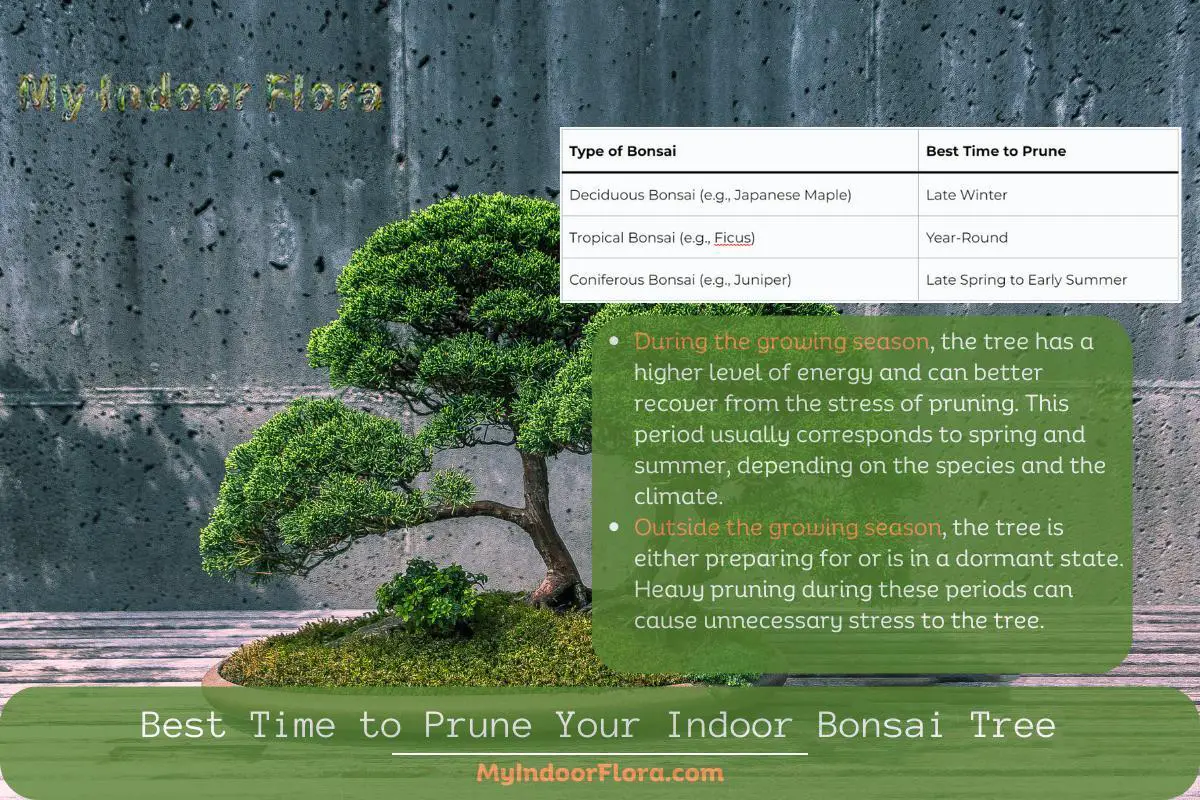
What Tools are Needed for Pruning Bonsai Trees?
The art of Bonsai shaping and pruning demands precision. The right tools make a significant difference in the effectiveness of your pruning and the overall health of your tree. Here are the must-have tools for pruning Bonsai trees:
- Bonsai Scissors: Bonsai scissors, also known as shears, are arguably the most used Bonsai tool. They come in various sizes and types, each designed for a specific purpose. The standard Bonsai scissors are great for general pruning, while the smaller, slim-profile ones are perfect for detail work like trimming buds, twigs, and leaves.
- Concave Cutters: These are special Bonsai tools that allow you to make cuts that leave a concave wound, promoting better healing. They are used primarily for cutting branches.
- Knob Cutters: Used for cutting heavy branches and roots or removing knobs and other unwanted protrusions from the trunk. These leave a spherical cut behind, assisting the tree in healing over the wound without leaving unsightly scars.
- Jin Pliers: Used for bending wires around the branches when shaping the tree, and for removing the wire without damaging the tree.
- Wire Cutters: Essential for removing the shaping wires once the branches have set in their new shape.
| Tool | Purpose |
|---|---|
| Bonsai Scissors | General pruning, trimming buds, twigs, and leaves |
| Concave Cutters | Cutting branches, leaving a concave wound for better healing |
| Knob Cutters | Cutting heavy branches and roots, removing knobs |
| Jin Pliers | Bending and removing shaping wires |
| Wire Cutters | Removing shaping wires |
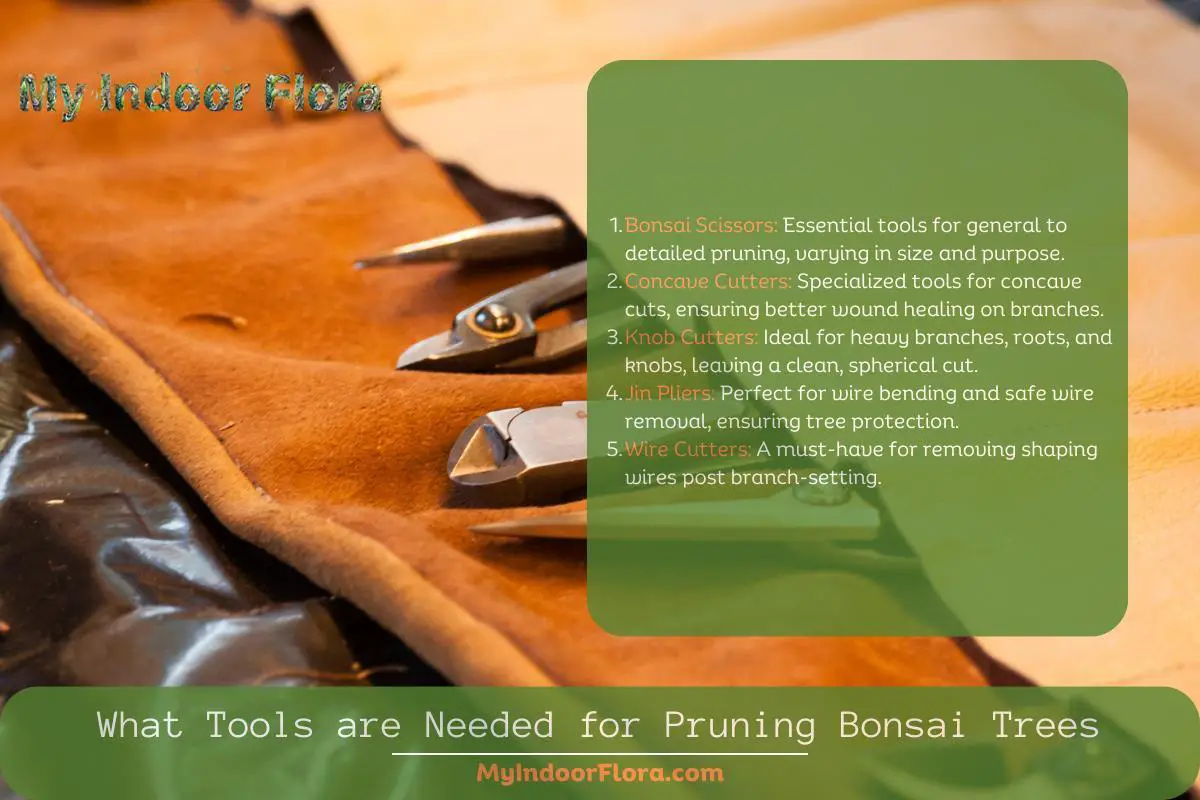
According to Bonsai master Nobuyuki Kajiwara, investing in quality tools is crucial for successful Bonsai care. He mentions that the use of poor-quality tools can lead to frayed cuts, which hinder the tree’s healing process.
How Should You Prepare Your Bonsai Tree for Pruning?
Pruning is a stressful process for any tree, and it’s essential to ensure your Bonsai is in optimal health before starting. Here are some steps to prepare your Bonsai for pruning:
- Check the Health of Your Tree: Look for any signs of disease or pest infestation. The tree should be in good health before you prune. Sick trees might not recover well from the stress of pruning.
- Study the Shape and Form of Your Tree: Understanding the natural shape of your tree will help you plan your pruning strategy. Each tree is unique, and an effective pruning technique maintains and enhances the tree’s natural form.
- Hydrate the Tree: Water your Bonsai thoroughly a day before pruning. A well-hydrated tree is better equipped to deal with the shock of pruning.
- Clean Your Tools: To prevent any potential spread of disease, ensure all your tools are clean and sharp.
- Create a Calm Environment: Trees are sensitive to their environment. Try to prune in a quiet, calm space where the tree is not exposed to harsh elements or drastic temperature changes.
Peter Chan, a Bonsai author and enthusiast, suggests, “Never rush when you are about to prune your Bonsai. Give it thought, plan ahead, and work with mindfulness and intention. Your tree will respond to your patience and care.”
Related Article: How To Prune Indoor Plants?
What are the Techniques of Pruning a Bonsai Tree?
Pruning techniques vary depending on the style and shape you’re aiming for, as well as the specific type of Bonsai. However, there are fundamental techniques that every Bonsai enthusiast should know:
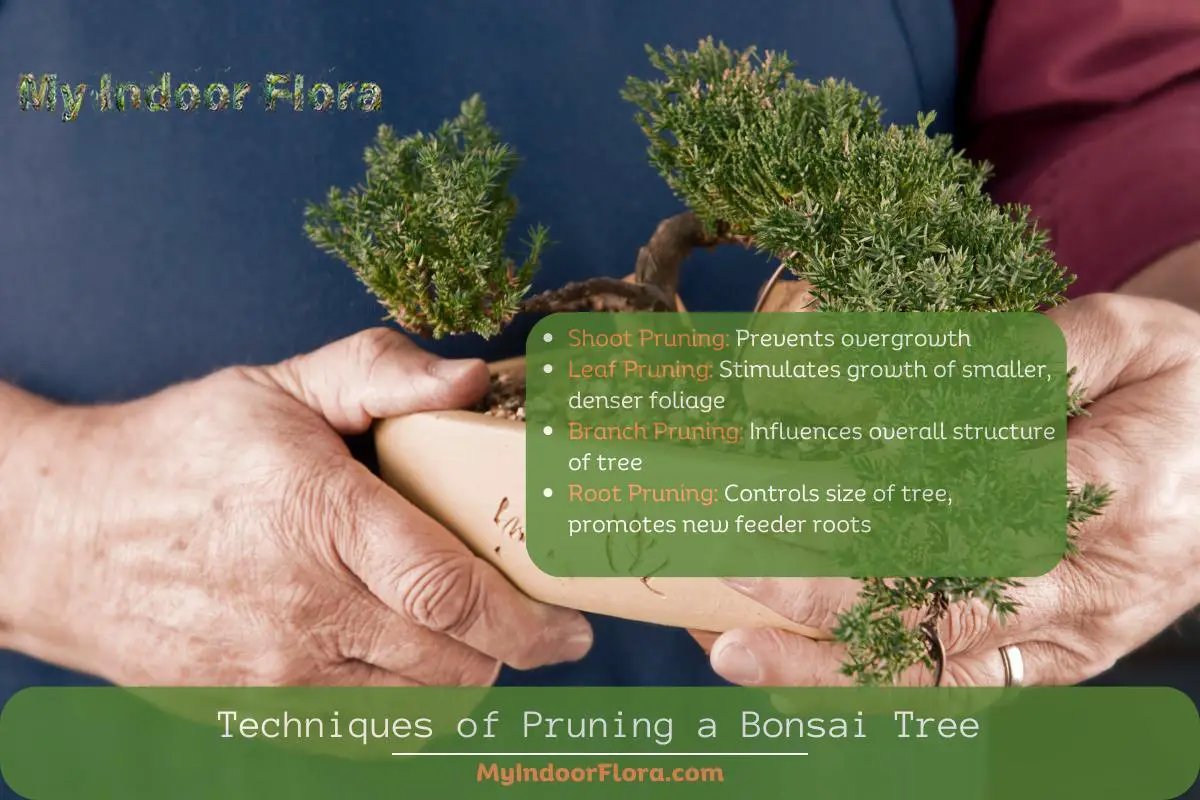
- Shoot Pruning: Also known as pinching, this technique involves removing new shoots to prevent overgrowth. The shoot is pinched at the base using fingers or tweezers. This technique is often used in deciduous and flowering species.
- Leaf Pruning: This involves removing leaves to stimulate the growth of smaller, denser foliage. Leaf pruning is commonly performed in the summer months, primarily on deciduous trees.
- Branch Pruning: Branches are pruned to influence the overall structure of the tree. Larger branches are usually cut using a concave cutter to leave a wound that heals with minimal scarring.
- Root Pruning: Performed when repotting the Bonsai, this technique involves trimming the roots to control the size of the tree and promote the growth of new, fine feeder roots.
| Technique | Purpose | Typical Timing |
|---|---|---|
| Shoot Pruning | Prevents overgrowth | As needed |
| Leaf Pruning | Stimulates growth of smaller, denser foliage | Summer |
| Branch Pruning | Influences overall structure of tree | As needed |
| Root Pruning | Controls size of tree, promotes new feeder roots | During repotting |
A study published in the Journal of Bonsai Science describes these techniques as being key to maintaining the aesthetics and balance of Bonsai trees.
How to Perform Maintenance Pruning on Your Indoor Bonsai Tree?
Maintenance pruning is all about preserving the existing shape of the Bonsai and keeping it healthy. This technique is generally performed throughout the growing season. Here are some steps to perform maintenance pruning:
- Pinch off New Shoots: Pinch or cut off new shoots that have grown too long or are disrupting the shape of the tree. Always leave at least one pair of leaves on the shoot to facilitate photosynthesis.
- Trim the Foliage: Remove excess foliage that is blocking sunlight to inner leaves. The idea is to thin out the foliage to ensure all leaves get adequate sunlight.
- Remove Unwanted Growth: Look for any growth in undesirable areas, such as the underside of branches or the base of the trunk. Removing these ensures that the tree’s energy is not wasted.
- Prune Overgrown Branches: Trim back any branches that have grown too long or are disrupting the tree’s balance.
- Check for Dead Branches: Remove any dead or dying branches to maintain the health of the tree and prevent disease spread.
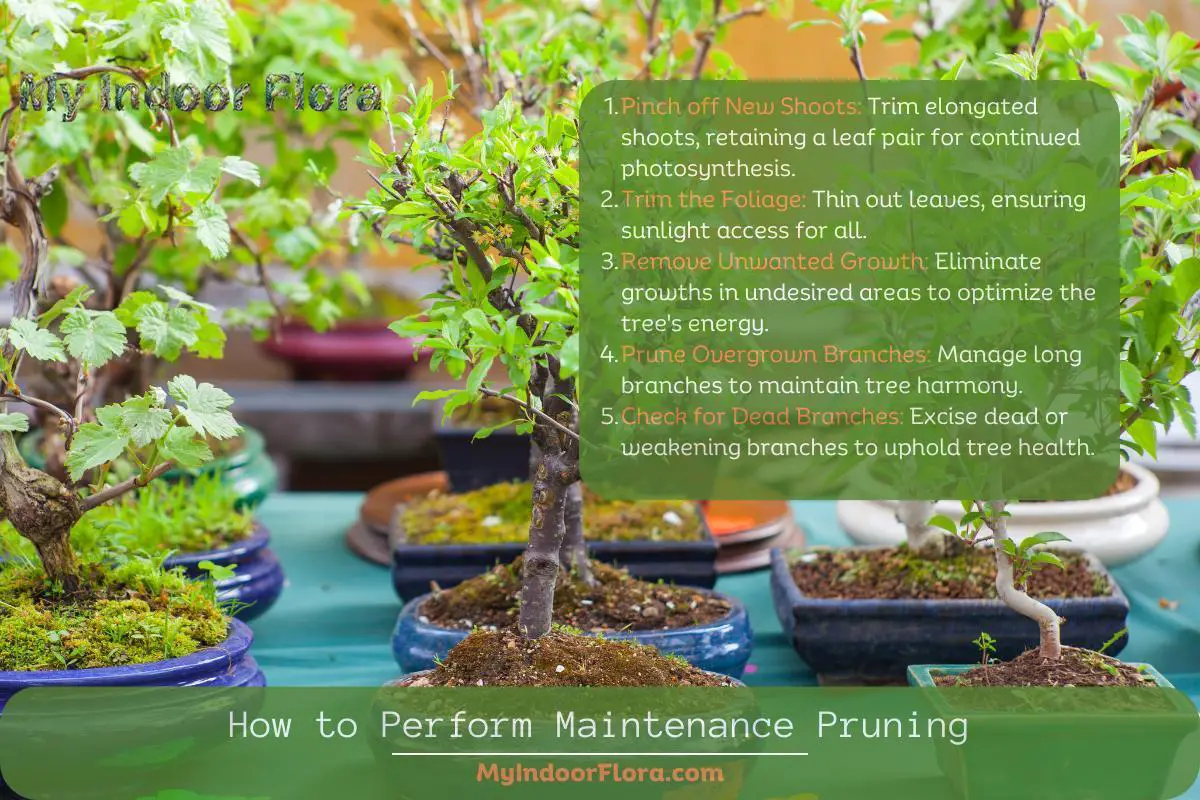
When doing maintenance pruning, it’s important to work slowly and methodically, evaluating the tree’s shape after each cut. Remember, it’s always better to cut too little than too much. As the famed Bonsai master John Naka once said, “Remember, Bonsai is not the result; it is the process.”
How to Conduct Structural Pruning for Your Bonsai Tree?
Structural pruning shapes the Bonsai and is often conducted in the tree’s dormant period—usually late winter or early spring—to minimize stress. This pruning shapes the tree’s fundamental structure, and thus, must be done carefully. Here are some steps to conduct structural pruning:
- Decide on the Front of the Tree: Before pruning, decide which side of the tree will be the front. This will guide your decisions on branch removal and shaping.
- Evaluate the Tree: Examine the tree’s overall form and identify branches that disrupt its balance. This could include branches that are too thick, those that cross other branches, or those growing directly towards or away from the viewer.
- Begin Pruning: Starting from the bottom of the tree and working upwards, begin pruning back unwanted branches. Use concave cutters to achieve a smooth cut that will heal cleanly.
- Trim Back Long Branches: Branches that have grown too long should be trimmed back to maintain the Bonsai’s shape. However, be careful not to remove too much at once.
- Wire and Shape Branches: After pruning, you may need to use wire to guide the remaining branches into their new positions. This should be done carefully to avoid damaging the bark.
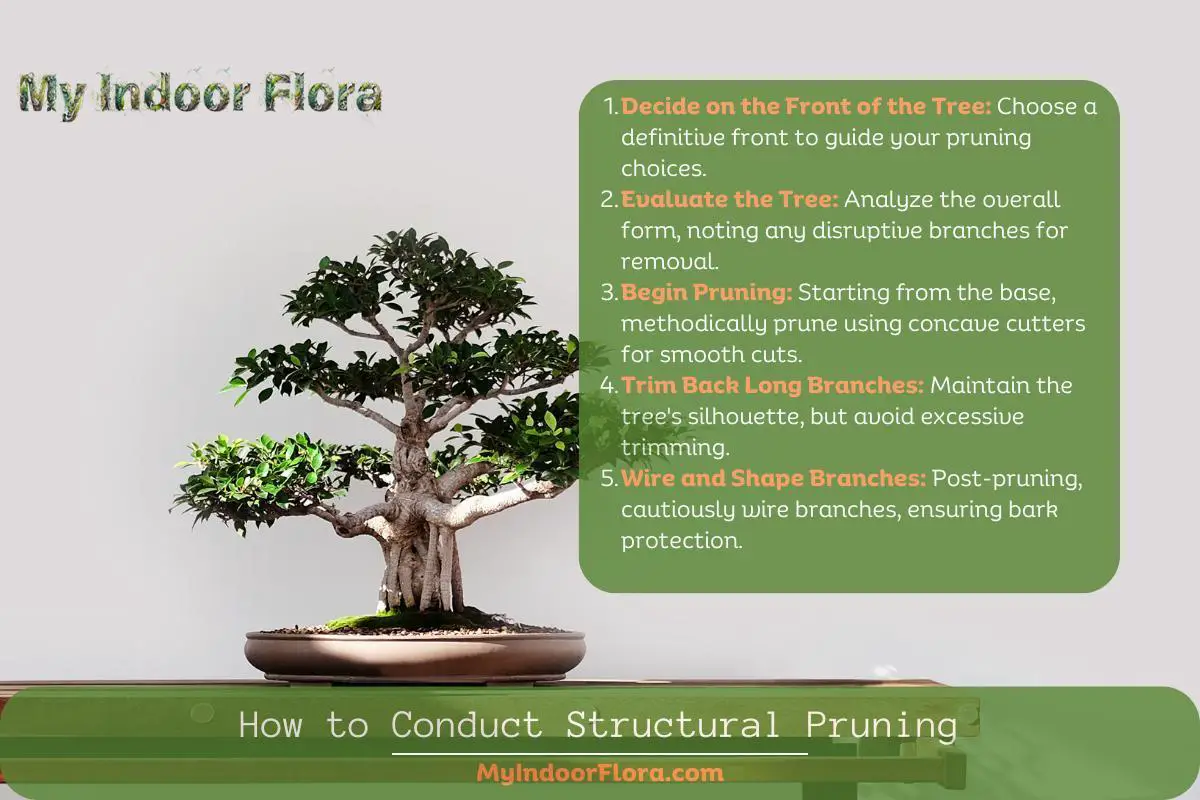
In a paper in the Journal of Bonsai Science, expert Masashi Hirao stated, “Structural pruning is a delicate operation that should be undertaken with a clear plan in mind. Consideration of the tree’s natural form is key to achieving a harmonious result.”
What are the Best Practices for Post-Pruning Care?
The care you provide after pruning is crucial to the tree’s recovery. Here are some best practices for post-pruning care:
- Water the Tree: After pruning, the tree will need plenty of water to recover. However, avoid watering immediately after pruning to prevent rotting of the fresh cuts.
- Avoid Fertilizing Immediately: Do not fertilize the tree right after pruning. Allow the tree to recover and start healing before introducing any fertilizers.
- Provide Adequate Sunlight: While the tree needs plenty of light for photosynthesis, avoid placing it in direct sunlight right after pruning, as this could cause the leaves to dry out.
- Monitor the Tree’s Health: Keep an eye on the tree’s overall health in the weeks following pruning. Look out for any signs of disease or stress.
- Keep the Tree in a Stable Environment: To aid recovery, keep the tree in a calm and stable environment. Avoid temperature fluctuations and windy conditions.
Post-pruning care is just as important as the pruning itself in promoting a tree’s health and aesthetics. As Bonsai expert, Robert Steven, suggests, “Bonsai is a living art. Each action on the tree reverberates through its growth. Therefore, aftercare is crucial in this delicate equilibrium.”
How Can Common Mistakes in Pruning Bonsai Trees be Avoided?
While pruning a Bonsai tree can be a rewarding experience, beginners can sometimes make mistakes that can negatively impact the health and aesthetics of the tree. Here are some common mistakes and how they can be avoided:
- Excessive Pruning: One of the most common mistakes is over-pruning. Remember, the aim is not to drastically alter the tree’s size but to maintain its shape and promote its health. Always prune sparingly and step back frequently to evaluate your progress.
- Incorrect Timing: Timing is crucial when it comes to pruning Bonsai. Generally, structural pruning should be done during the tree’s dormant phase to reduce stress, while maintenance pruning can be done throughout the growing season. Pruning at the wrong time can harm the tree.
- Using Dull or Dirty Tools: Using dirty or dull tools can introduce pathogens into the tree and make rough cuts that take longer to heal. Always use sharp, clean tools for pruning.
- Inadequate Aftercare: After pruning, the tree needs adequate care to recover. This includes proper watering, avoiding direct sunlight, and refraining from fertilizing until the tree has had a chance to heal.
- Improper Branch Selection: When conducting structural pruning, choose which branches to remove carefully. Removing an important branch can harm the tree and disrupt its balance.
- Ignoring the Tree’s Natural Shape: Every tree species has a natural form that it tends towards. Ignoring this when pruning can result in an unnatural-looking Bonsai.
Renowned Bonsai artist, Peter Warren, states in his book “Bonsai: Techniques, Styles, Display Ideas,” that understanding the tree, its growth patterns, and its natural shape are key to avoiding common pruning mistakes.
How to Troubleshoot Problems That Arise After Pruning?
Despite careful pruning and aftercare, problems may arise post-pruning. Identifying and addressing these issues promptly can prevent long-term damage to your Bonsai. Here’s how you can troubleshoot common problems:
- Leaf Browning or Wilting: This could be due to over-pruning or lack of water. If you notice this, reduce the amount of pruning and ensure the tree is adequately watered.
- Disease or Pest Infestation: If you notice discoloration, spots, or pests on your tree, you may need to apply a fungicide or pesticide. Consult with a Bonsai specialist to identify the specific disease or pest and treat it effectively.
- Slow Recovery: If your tree seems slow to recover after pruning, it may be stressed. Ensure it is receiving adequate light, but not direct sunlight, and avoid fertilizing until it recovers.
- Rot at the Cut Sites: If the cuts are rotting, this could be due to over-watering post-pruning or pruning during a period of high humidity. Cut off the rotted areas to prevent the spread of disease and consult a specialist.
- Unusual Growth Patterns: If the tree starts to grow in an unexpected way, you may have pruned too much or too little. Consult with a Bonsai expert to determine how to restore balance to the tree.
Peter Chan, author of “Bonsai Masterclass,” advises that if you are unable to determine the cause of the problem or how to treat it, it’s best to consult with a Bonsai specialist. Their expertise can help you identify the issue and determine the best course of action.
Conclusion
In the world of Bonsai, pruning isn’t just a routine task; it’s an art form that embodies the gardener’s connection with the tree. Like any art form, it takes time and practice to master. However, with the right knowledge and tools at your disposal, you can ensure your Bonsai tree remains healthy, beautiful, and truly yours.
